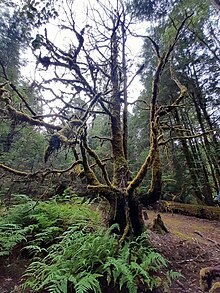| Hymenophyton flabellatum | |
|---|---|

| |
| Scientific classification | |
| Kingdom: | Plantae |
| Division: | Marchantiophyta |
| Class: | Jungermanniopsida |
| Order: | Pallaviciniales |
| Family: | Hymenophytaceae |
| Genus: | Hymenophyton |
| Species: | H. flabellatum |
| Binomial name | |
| Hymenophyton flabellatum (Labill.) Dumort. ex Trevis | |
Hymenophyton flabellatum is a species of the order Pallaviciniales (liverworts), one of perhaps several species in the genus Hymenophyton. It is a dendroid thalloid liverwort belongs to the family Hymenophytaceae and is commonly known as Fan liverwort. It is found in New Zealand, Chile, and common in wet forests of Australia and Tasmania. Hymenophyton flabellatum closely resembles with small filmy fern, Hymenophyllum and can be confused with the liverwort, Symphyogyna hymenophyllum.

Description
Hymenophyton flabellatum is plagiotropic, branched rhizome-like axes with aerial shoots divided into upright stalks. Palmate fronds or flabellate are olive green, with forking, 5-6 times and forked thallus wings spreading out horizontally. Segments are flat, slightly undulate at borders, 0.8 to 1.2mm in wide. Segments with obtuse apex are limited in growth. Growing apex contains 1-celled marginal slime papillae Lamina cells are 35-49μm in length, 23-30μm wide, 23-35μm thickness. Marginal cells are short of 18-23 μm in length and 33-35μm in width. 3 to 4 or 5 to 6 male branches per frond which are lateral on stalk or nerve bifurcation. Female scale has toothed margin. Hymenophyton species produce spores and disperse through a spirally thickened, elongate structure called elaters.
The central strand of Hymenophyton flabellatum contains long and axially elongated water conducting cells with pointed ends. The mature water conducting cells lack living contents and thickened wall of water conducting cells possess oblique slit shaped depression. Adjacent cells connected through small perforations within the depression.
Distribution and habitat
Hymenophyton flabellatum commonly found in New Zealand, Australia, Tasmania, Chile in rain forest and wet forest. It grows on shaded wet soil, humus, and old logs in forest, and along rivers sides. Bush Blitz survey 2010 reported the prenece of Hymenophyton flabellatum in two locations, Seventeen Mile plain, Vale of Belvoir reserves, Tasmania. Additional report recorded the presence of this liverwort in Teepookana forest site in Tasmania, found on fallen portion of the old Huon pine tree.
Phytochemicals
Apigenin 6,8-di-C-glycosides have been detected as characteristic chemical compounds in Hymenophyton flabellatum. Pungent-tasting chemical compound 1-(2,4,6-trimethoxyphenyl)-but-2(E)-en-1-one was isolated from ether extract of Hymenophyton flabellatum. This chemical compound is responsible for the pungent taste of H. flabellatum upon chewing.
Insect relation
Hymenophyton flabellatum is act as a larval host, provide home and food for Sabatinca chalcophanes.
References
- Pfeiffer, Tanja (2000). "Molecular relationship of Hymenophyton species (Metzgeriidae, Hepaticophytina) in New Zealand and Tasmania. Studies in austral temperate rain forest bryophytes 5". New Zealand Journal of Botany. 38 (3). The Royal Society of New Zealand: 415–423. doi:10.1080/0028825X.2000.9512693.
- ^ Pfeiffer, Tanja; Schaumann Friederike; Menéndez Gabriela G. Hässel de; Frey Wolfgang (2004). "Inter- and infraspecific relationships in the Gondwanan liverwort genus Hymenophyton (Hymenophytaceae, Hepaticophytina). Studies in austral temperate rain forest bryophytes 23" (PDF). Australian Systematic Botany. 17 (4): 407–421. doi:10.1071/SB03022.
- "Key to Tasmanian Dicots". www.utas.edu.au. Retrieved 2021-03-17.
- "Bryophyte Ecology ebook | Michigan Technological University Research | Digital Commons @ Michigan Tech". digitalcommons.mtu.edu. Retrieved 2021-03-17.
- Burr, R. J.; Butterfield, B. G.; Hébant, Charles (1974). "A Correlated Scanning and Transmission Electron Microscope Study of the Water-Conducting Elements in the Gametophytes of Haplomitrium gibbsiae and Hymenophyton flabellatum". The Bryologist. 77 (4): 612–617. doi:10.2307/3241807. ISSN 0007-2745. JSTOR 3241807.
- ^ ASAKAWA, Yoshinori; TOYOTA, Masao; OISO, Yasushi; Braggins, John E. (2001). "Occurrence of Polygodial and 1-(2,4,6-Trimethoxyphenyl)-but-2-en-1-one from Some Ferns and Liverworts: Role of Pungent Components in Bryophytes and Pteridophytes Evolution". Chemical & Pharmaceutical Bulletin. 49 (10): 1380–1381. doi:10.1248/cpb.49.1380. ISSN 0009-2363. PMID 11605679.
- Yumpu.com. "egg islands, Flat rock, lower porter hill and porter hill ... - BushBlitz". yumpu.com. Retrieved 2021-03-17.
- Jarman, S. J.; Kantvilas, G. (1995). "Epiphytes on an old Huon pine tree ( Lagarostrobos franklinii ) in Tasmanian rainforest". New Zealand Journal of Botany. 33 (1): 65–78. doi:10.1080/0028825X.1995.10412944. ISSN 0028-825X.
- Markham, Kenneth R.; Porter, Lawrence J.; Campbell, Ella O.; Chopin, Jean; Bouillant, Marie-Louise (1976). "Phytochemical support for the existence of two species in the genus Hymenophyton". Phytochemistry. 15 (10): 1517–1521. doi:10.1016/s0031-9422(00)88928-1. ISSN 0031-9422.
- Toyota, Masao; Omatsu, Ikuko; Braggins, John; Asakawa, Yoshinori (2009). "Pungent Aromatic Compound from New Zealand Liverwort Hymenophyton flabellatum". Chemical & Pharmaceutical Bulletin. 57 (9): 1015–1018. doi:10.1248/cpb.57.1015. ISSN 0009-2363. PMID 19721269.
- "Bryophyte Ecology Volume 2 ebook | Bryophyte Ecology | Michigan Technological University". digitalcommons.mtu.edu. Retrieved 2021-03-17.
| Taxon identifiers | |
|---|---|
| Hymenophyton flabellatum | |